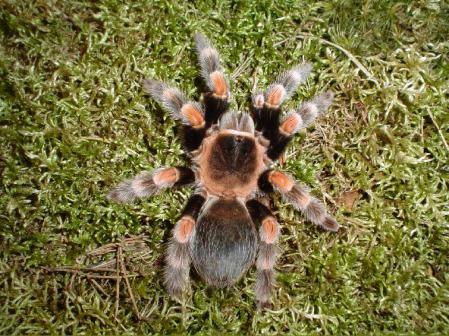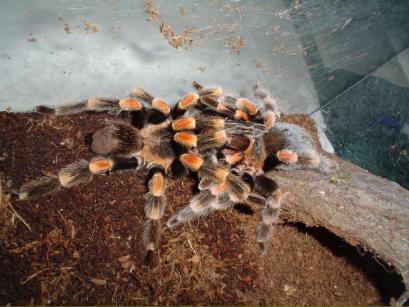
Breeding attempt of Brachypelma smithi
Michal Toran
Brachypelma smithi (Cambridge, 1897) is one of the most
attractive and most beautiful species of tarantula. Its native country is Mexico and, in the past, the areas of habitation of this species have been fairly plundered (all the more reason to breed
them at home). I think that any detailed descriptions of this kind would be a waste of time because an overwhelming majority of breeders
know B. smithi very well.
I managed to find an older, fresh mature male (which had already successfully mated 3 times) after two months after our female's last moult. On 13 March 2004, I placed the male into a plastic
perforated box and put him into the female's terrarium during evening hours, at about 6 pm. Nothing important happened during the first moments, the female stood on the box and at first she
didn't emit any signals, which could show evidence of her appetite to mating. The male was vibrating and courting for a while, however, he didn't drum. After one hour, I let the male out from his
box. The female went towards him very carefully, the male was still vibrating and he was also approaching. The female moved towards the male and he pushed her up carefully with his tibial hooks.
However, he didn't reach the female's genital opening with his bulbs in this position and so we had to help the female by pushing her abdomen over to the male. Afterwards, the male successfully
pushed his left embolus into the female's genital opening four times. After the end of this act, the female started to go out of this position but she behaved calmly. The male was caught and put back
into his own terrarium. The day after, the male re-charged his palps in his terrarium during the afternoon hours. On 16 March 2004, the male was again let into the female's terrarium. As nothing was
happening and both participants were apathetic, I was forced to separate them. I again placed the male into the female's terrarium in the evening on 17 March. This time she responded very quickly to
the male. However, this time the male was scared of her although he tried to hold her up with his tibial hooks several times. The female was calm during this act, sometimes she even raised her front
legs but the male didn't manage to pair with her. And so they were again separated. Then I returned the male to its original keeper. There was no choice but to wait. The female was fed a middle-sized
pinkie mouse after mating and her behaviour was not unusual.
May 2005: nothing strange occured to the female. I kept the terrarium slightly humid. Temperature is always about 25oC,
at times about 28oC (a heating stone is in a nearby terrarium). The female is darker, she still stays on the top of her hiding place and sometimes she eats a large cricket.
June 2005: the female starts to darken on her abdomen. Unfortunately, everything indicates that the mating didn't turn out well. If the female moults, I will try to repeat the pairing and
breeding.
Literature used: František Kovarík, Sklípkani, Madagaskar Jihlava,
1998

